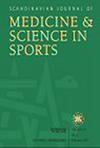BAMIC评估优秀田径运动员腿筋损伤的临床表现和康复进展
IF 3.8
2区 医学
Q1 SPORT SCIENCES
引用次数: 0
摘要
主要目的是报告腘绳肌损伤后初步评估的临床特征,以及这些特征与损伤机制、BAMIC和恢复充分训练时间(TRFT)的关系。第二个目的是监测康复期间的功能里程碑,并评估与BAMIC和TRFT相关的功能里程碑。优秀田径运动员的腿筋损伤符合入选条件。记录临床指标和达到康复和TRFT功能里程碑的时间。急性损伤前一周的腰痛和腘绳肌痉挛/紧绷分别出现在30%的损伤中。最大髋关节屈曲活动膝关节伸展(MHFAKE)减少(p = 0.04), MHFAKE不对称增加(p = 0.01),视觉模拟量表(VAS)行走疼痛增加(p = 0.001)和腿肌收缩抵抗(p = 0.01)与TRFT相关。BAMIC损伤组在行走和腘绳肌收缩时的VAS疼痛评分较高,慢跑时需要更长时间,被动膝关节伸展时无疼痛(p = 0.04)。恢复无疼痛慢跑的时间、无疼痛和全功率手动肌肉测试、Askling H测试阴性和完全被动ROM与TRFT相关。无痛触诊(p = 0.69)与TRFT无关。c级损伤在临床上很难发现,但较高的VAS疼痛评分和较长的范围限制可能与临床相关。MHFAKE和VAS对行走和腘绳肌收缩的影响可能有助于预后。腰痛和腿筋紧绷/抽筋是急性腿筋损伤前的常见症状。本文章由计算机程序翻译,如有差异,请以英文原文为准。
Clinical Presentation and Rehabilitation Progression Following Hamstring Injury Assessed by BAMIC in Elite Track and Field
The primary aim was to report clinical features at initial assessment after hamstring injury, and the association of these with the mechanism of injury, BAMIC, and time to return to full training (TRFT). A secondary aim was to monitor functional milestones during rehabilitation and assess these relative to BAMIC and TRFT. Hamstring injuries in elite track and field athletes were eligible for inclusion. Clinical markers and the time to reach functional milestones in rehabilitation and TRFT were recorded. Low back pain and hamstring cramping/tightness in the week prior to acute injury were, independently, present in 30% of injuries. A reduction in Maximal Hip Flexion Active Knee Extension (MHFAKE) (p = 0.04), greater MHFAKE asymmetry (p = 0.01), increased Visual Analogue Scale (VAS) pain on walking (p = 0.001) and resisted hamstring contraction (p = 0.01) were associated with TRFT. BAMIC c injuries had a higher VAS pain score on walking and hamstring contraction, took longer to jog, and for passive knee extension to be pain free (p = 0.04). Time to return to pain‐free jogging, pain‐free and full power on manual muscle testing, Askling H‐test negative, and full passive ROM were associated with TRFT. Pain‐free palpation (p = 0.69) was not associated with TRFT. Class c injuries are challenging to detect clinically, but a higher VAS pain score and prolonged restriction in range may be clinical associations. MHFAKE and VAS on walking and hamstring contraction may be helpful in prognostication. Low back pain and hamstring tightness/cramping are common symptoms prior to acute hamstring injury.
求助全文
通过发布文献求助,成功后即可免费获取论文全文。
去求助
来源期刊
CiteScore
7.90
自引率
4.90%
发文量
162
审稿时长
3 months
期刊介绍:
The Scandinavian Journal of Medicine & Science in Sports is a multidisciplinary journal published 12 times per year under the auspices of the Scandinavian Foundation of Medicine and Science in Sports.
It aims to publish high quality and impactful articles in the fields of orthopaedics, rehabilitation and sports medicine, exercise physiology and biochemistry, biomechanics and motor control, health and disease relating to sport, exercise and physical activity, as well as on the social and behavioural aspects of sport and exercise.

 求助内容:
求助内容: 应助结果提醒方式:
应助结果提醒方式:


